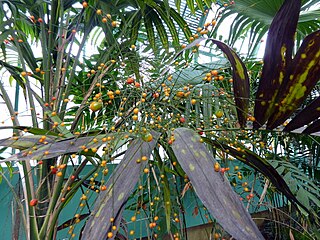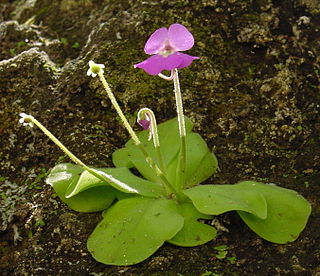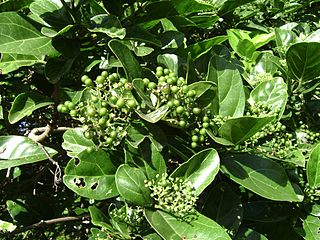
The stamen is the pollen-producing reproductive organ of a flower. Collectively the stamens form the androecium.

The family Campanulaceae, of the order Asterales, contains nearly 2400 species in 84 genera of herbaceous plants, shrubs, and rarely small trees, often with milky sap. Among them are several familiar garden plants belonging to the genera Campanula (bellflower), Lobelia, and Platycodon (balloonflower). Campanula rapunculus and Codonopsis lanceolata are eaten as vegetables. Lobelia inflata, L. siphilitica and L. tupa and others have been used as medicinal plants. Campanula rapunculoides may be a troublesome weed, particularly in gardens, while Legousia spp. may occur in arable fields.

The scarlet gourds are a genus with 25 species. It is distributed in sub-Saharan Africa and with one species, C. grandis also in South and South-east Asia, and it is also introduced into the New World. Incidentally, C. grandis is also a cultivated crop and it is used for culinary and medical purposes.

The stigma is the receptive tip of a carpel, or of several fused carpels, in the gynoecium of a flower.

The Hernandiaceae are a family of flowering plants, angiosperms, in the order Laurales. Consisting of five genera with about 58 known species, they are distributed over the world's tropical areas, some of them widely distributed in coastal areas, but they occur from sea level to over 2000 m.

Calyceraceae is a plant family in the order Asterales. The natural distribution of the about sixty species belonging to this family is restricted to the southern half of South-America. The species of the family resemble both the family Asteraceae and the Dipsacaceae.

A flower, sometimes known as a bloom or blossom, is the reproductive structure found in flowering plants. The biological function of a flower is to facilitate reproduction, usually by providing a mechanism for the union of sperm with eggs. Flowers may facilitate outcrossing resulting from cross pollination or allow selfing when self pollination occurs.

The Proteaceae are a family of flowering plants predominantly distributed in the Southern Hemisphere. The family comprises 83 genera with about 1,660 known species. Together with the Platanaceae and Nelumbonaceae, they make up the order Proteales. Well-known genera include Protea, Banksia, Embothrium, Grevillea, Hakea and Macadamia. Species such as the New South Wales waratah, king protea, and various species of Banksia, soman, and Leucadendron are popular cut flowers. The nuts of Macadamia integrifolia are widely grown commercially and consumed, as are those of Gevuina avellana on a smaller scale. Australia and South Africa have the greatest concentrations of diversity.

Catalpa bignonioides is a species of Catalpa that is native to the southeastern United States in Alabama, Florida, Georgia, Louisiana, and Mississippi. Common names include southern catalpa, cigartree, and Indian-bean-tree.
This page provides a glossary of plant morphology. Botanists and other biologists who study plant morphology use a number of different terms to classify and identify plant organs and parts that can be observed using no more than a handheld magnifying lens. This page provides help in understanding the numerous other pages describing plants by their various taxa. The accompanying page—Plant morphology—provides an overview of the science of the external form of plants. There is also an alphabetical list: Glossary of botanical terms. In contrast, this page deals with botanical terms in a systematic manner, with some illustrations, and organized by plant anatomy and function in plant physiology.
Plectocomiopsis is a dioecious genus of flowering plant in the palm family found in Indochina, Malaysia, Borneo and Sumatra. Hapaxanthic and armed with spines, they are a climbing rattan, closely related to the Myrialepis palms. The name is Greek for "similar to Plectocomia", another close relative.

Synechanthus is a monoecious genus of flowering plant in the palm family found in Mexico, Central and South America. Commonly called bola, palmilla, or jelly bean palm, they are closely related to members of Chamaedorea, only distinguished by their flower and fruit form. The Greek genus name is a combination of "united" and "flower".
This glossary of botanical terms is a list of definitions of terms and concepts relevant to botany and plants in general. Terms of plant morphology are included here as well as at the more specific Glossary of plant morphology and Glossary of leaf morphology. For other related terms, see Glossary of phytopathology and List of Latin and Greek words commonly used in systematic names.

Hydnora africana is an achlorophyllous plant in the family Hydnoraceae, native to southern Africa that is parasitic on the roots of members of the family Euphorbiaceae. It is also called jakkalskos or jackal food. The genus name comes from the Greek word hydnon, which translates to "truffle," and the specific epithet africana means to be from Africa. Molecular data has suggested that Hydnoraceae is a "basal angiosperm" solidifying its place among the more primitive flowering plants. Hydnoraceae are the only angiosperms known to have no leaves or scales and are considered obligate parasites, completely dependent on their hosts to survive. The plant grows underground, except for a fleshy flower that emerges above ground and emits an odor of feces to attract its natural pollinators, dung beetles and carrion beetles. The vegetative body of the plants has been reduced to only consisting of roots and flowers. The flowers act as temporary traps, retaining the beetles that enter long enough for them to pick up pollen.

Pinguicula elizabethiae is a perennial rosette-forming insectivorous herb native to the Mexican states of Querétaro and Hidalgo. A species of butterwort, it forms summer rosettes of flat, succulent leaves up to 5 centimeters (4 in) long, which are covered in mucilaginous (sticky) glands that attract, trap, and digest arthropod prey. Nutrients derived from the prey are used to supplement the nutrient-poor substrate that the plant grows in. In the winter the plant forms a non-carnivorous rosette of small, fleshy leaves that conserves energy while food and moisture supplies are low. Single purple flowers appear between July and October on upright stalks up to 75 millimeters long.

Premna serratifolia is a small tree/shrub in the family Lamiaceae. It flowers and fruits between May and November. During flowering season, it attracts a large number of butterflies and bees. Synonyms of Premna serratifolia Linn. include P. corymbosa Merr., P. integrifolia L. and P. obtusifolia R. Br.).

Passiflora mixta, from the family Passifloraceae is also known as curuba, curuba de indio, curuba de monte, curubita, curuba (Colombia), parcha (Venezuela), and taxo (Ecuador). Originally, it derived from the monophyletic Adeans Passiflora subgenus Tacsonia. Passiflora includes 47 species, one of which is Passiflora mixta which can be found in Southern America. A perennial vine, the Passiflora mixta is pink to orange-red in color.

Monopsis is a genus of small, Lobelia-like herbaceous plants indigenous to Africa. A few species are annuals, but most are perennials. Common names are not well established, but often refer to more familiar plants, as in "wild violet" for Monopsis unidentata, "yellow lobelia" for Monopsis lutea or "pansy lobelia" for Monopsis debilis.
Trompettia cardenasiana is a spiny shrub bearing very small leaves, 0.35–0.5 cm (0.1–0.2 in) by 0.1–0.12 cm (0.04–0.05 in), a yellow trumpet-shaped campanulate flower, measuring about 3 cm (1.2 in) long and globose fruit. The growth habit is somewhat reminiscent of certain Lycium species. It is endemic to Bolivia, growing in dry, Andean valleys at altitudes of 2,000–2,500 m (6,600–8,200 ft) and 3,000–3,500 m (9,800–11,500 ft) and has been collected near the town of Cotagaita in Potosí Department.

Jamesbrittenia ramosissima is a Southern African shrub in the family Scrophulariaceae occurring in the Northern Cape and southern Namibia, westward along the Gariep River from the vicinity of Augrabies Falls. It is one of some 90 species in the genus Jamesbrittenia, ranging through Africa, with 74 species occurring in Southern Africa, and 1 in India. The genus is named for James Britten (1846-1924), medical student turned botanist, and acting Keeper of Botany at the British Museum when Kuntze named it.
















